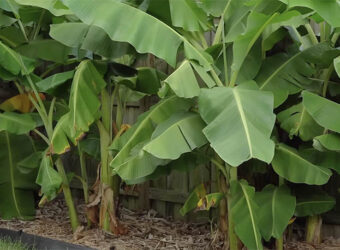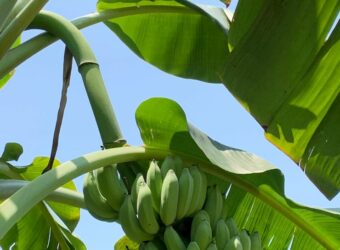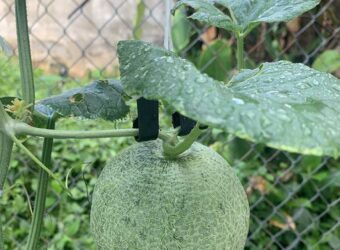One of the best parts of summer is picking a ripe tomato and eating it seconds later, only a few feet away from where it was picked. When the fruit at the peak of ripeness and still warm from the sun, the flavor bursts in my mouth, and juice drips down my chin.
While these delicious fruits are why I grow tomatoes, you can’t have healthy fruits without a healthy tomato plant. And a healthy plant means green leaves!
Unfortunately, tomato plants are susceptible to a wide variety of environmental problems, diseases, and pests. One of the most common signs that an issue is present is yellowing tomato leaves.
In my years spent growing these garden favorites, I’ve witnessed hundreds of tomato leaves fade from vibrant green to a sad yellow color. Fortunately, I’ve learned a thing or two in the process.
Join me as I share some of the common reasons why tomato leaves turn yellow as well as what you can do to prevent and cure these issues.
Overwatering
While tomato plants need water to thrive, too much water can lead to numerous issues, including yellow leaves.
If you overwater your tomato plant, the roots may have a difficult time exchanging, absorbing nutrients, and taking up water. All of these can stress the plant and lead to yellow leaves.
Prevention
It may sound obvious, but the best way to prevent overwatering is to ensure you don’t water too much!
The amount of water a tomato plant needs will depend on the size of the plant, temperature, humidity, soil type, and natural rainfall. So when you’re determining how much to water your plant, you should look at each of these factors.
First, there’s the plant size. When I first plant a tomato seedling, I know the plant will use less water than a plant that’s five feet tall.
However, this shorter plant also has a smaller root system, which means it cannot reach water that’s deep in the soil. That means I know I will need to provide these small tomato plants with less water but also water them more frequently.
Larger tomato plants use more water than smaller tomato plants, but they also have larger root systems that can drink up water that is deeper in the ground.
As far as temperature goes, a higher temperature means you will need to provide your plant with more water. High temperatures mean water evaporates from the soil more quickly and more water escapes through the plant via transpiration.
I’ve seen all this play out with differences in spring and summer tomatoes. When I first plant tomatoes in the spring, they thrive when I water them only once or twice a week. But when the 90ºF days of summer arrive, plants will suffer if I don’t water them every other day.
Then there’s humidity. Higher humidity means less evaporation and transpiration.
Therefore, you’ll need to water your plants less during hot and humid weather than you will during hot and dry weather.
Finally, there’s soil type. No matter if you’re growing your tomatoes in the ground, in a raised bed, or in a container, you need to understand the composition of the soil.
Tomatoes prefer well-draining soil that also holds a bit of moisture. If the soil is compacted or high in clay, it may not drain well.
While you can just water your plant less, the best option is to improve the soil. Use a digging fork to gently lift and aerate the soil, and mix in some compost to improve the composition.
So, how much should you water tomato plants to prevent yellow leaves?
A good rule of thumb is to provide garden tomato plants with two inches of water each week. Plants grown in containers may need more water.
You should aim to keep the soil consistently moist, which means you apply this water throughout the week rather than all at once. I find that providing my tomato plants with about a pint to a quart of water every two to three days keeps them happy.
Solution
Stop watering so much! But really, the solution to overwatering is to decrease the amount and/or frequency that you water.
You can also look into improving the drainage of your soil mix.
It’s important to note that already yellow leaves are unlikely to turn back to green, but healthy new leaves can emerge.
Sudden Change in Environment
One of the things that continues to amaze me about plants is their ability to bounce back.
Every year, I do my best to slowly acclimate seedlings to their outdoor home and then carefully plant them in the ground. However, despite my best efforts, the plants appear stressed after transplanting.
The leaves become yellow and growth slows to a halt. However, I’ve learned not to worry too much.
That’s because as long as I provide the proper care, the plants will bounce back within a week.
All that’s to say that a sudden change in environment will inevitably create plant stress, which may lead to yellow leaves.
Prevention
The best way to prevent yellow leaves from sudden environmental changes is to avoid these changes entirely! While this isn’t always completely possible, you can take some steps to limit plant stress.
If you are planting seedlings in the ground outdoors, you should take care to acclimate them to their new environment before planting. This process is known as ‘hardening off.’
I like to move my seedlings outdoors while they’re still in their individual pots. For the first few days, I leave the seedlings out during the day and then bring them in at night.
After a few days of this, I leave the small plants outdoors for both day and night. This helps the plants acclimate the direct sunlight, outdoor temperatures, and wind.
By the time I plant the seedlings in the ground, they are more used to their new environment. With that said, I find that transplants may still show some signs of stress, and that’s okay.
Along with hardening off seedlings, you should also take measures to protect your plants from cold snaps. If you see the temperature is about to drop, drape a floating row cover over your plants to insulate them.
Solution
If you notice the lower leaves of your tomato plants are turning yellow after you transplant them, don’t panic. Transplanting is an inherently stressful process.
With that said, providing your plants with the appropriate amount of water and the right temperature will help them adjust to their new home.
Lack of Nutrients
Tomato plants are heavy feeders, which means they require plenty of nutrients to grow well. While some vegetable plants can survive off of fertilizer that is applied before planting, I find that tomato plants benefit from regular doses of fertilizer as they grow.
Tomato plants require 18 nutrients to thrive, but they receive three of these from their environment. Therefore, you will need to provide your plant with 15 other nutrients.
A deficiency in any of these nutrients can lead to plant problems, but yellow leaves only appear due to certain deficiencies.
A lack of nitrogen, magnesium, potassium, or iron may all result in yellow leaves.
However, the exact symptoms will vary depending on the nutrient that is lacking.
- Nitrogen (N) deficiency results in older leaves turning yellow while the leaves’ veins stay green. Yellow progresses from older to newer leaves.
- Magnesium (Mg) deficiency appears as older leaves slowly turning yellow from the outside to the inside. The veins remain green.
- Potassium (K) deficiency appears as the edges of older leaves turning yellow and then brown. The interiors of the leaves may remain green.
- Iron (Fe) deficiency first appears in younger leaves. These leaves turn yellow while the veins remain green.
Prevention
The best way to prevent nutrient deficiency is to ensure your plant has access to all necessary plant nutrients. However, this involves more than providing your plant with fertilizer.
First, you’ll want to check your soil pH, since nutrient availability is impacted by soil pH. A soil pH of 6.5 is considered ideal for tomatoes.
If your soil pH is too acidic (below 5.5) or too alkaline (above 7.5), plants will not be able to take up nutrients—even if they exist in the soil.
After you’ve tested your pH, you complete a soil test. This will let you know what nutrients are present in the soil and which are lacking.
While you can complete an at-home soil test using a kit, I find it’s best to send samples to a professional soil testing lab. You can check with your local agricultural extension service to see if they offer soil testing services.
Once you’ve received your results, you can determine if you need to correct your soil pH and/or add nutrients. Adding lime will raise soil pH while adding sulfur can help lower pH.
As far as nutrients go, your soil test will likely recommend what you need to apply to get your soil to a good baseline. From this point, you can use a special tomato fertilizer to keep your plants happy.
Both granular and liquid fertilizers are suitable options. Some good options include Espoma Organic Tomato Tone and Neptune’s Harvest Tomato and Veg Fertilizer.
I find that applying fertilizer once every two weeks keeps plants happy. Use the product instructions to determine how much fertilizer to apply, and make sure not to over-fertilize!
After you provide fertilizer, make sure to keep the soil moisture at an appropriate level. If the soil is dry or saturated, tomato plants will have a difficult time properly taking up nutrients.
Solution
The solution for a nutrient deficiency is similar to the prevention strategy mentioned above. However, by the time you notice your plant is sporting yellow leaves, it may be too late to correct the deficiency.
One option is to foliar feed your plants, which involves spraying a diluted fertilizer on the plant’s leaves. This may allow plants to take up nutrients more quickly than if you applied fertilizer to the soil.
You can use Neptune’s Harvest Tomato and Veg Fertilizer to correct some nutrient problems. However, be aware that if your plant is severely deficient in nutrients, it may not properly recover.
Diseases
Another common cause of yellowing tomato leaves is disease. Unfortunately, tomato plants are susceptible to a wide variety of diseases, many of which can turn their leaves yellow.
In general, diseases will cause leaves to develop yellow splotches rather than entire yellow leaves. Many diseases also cause brown or black spots.
Since many diseases that impact tomato foliage look similar, it can be difficult to determine the exact pathogen attacking your tomato plant. However, you can contact your local agricultural extension office for help with diagnosis.
With that said, here are some of the most common diseases that cause tomato leaves to turn yellow.
Early Blight
Early Blight is a fungal disease caused by Alternaria linariae.
The first sign of early blight is a spattering of small dark brown spots on older tomato leaves. These spots eventually become larger and develop faint rings.
The foliage around the spots then turns yellow. Eventually, the leaves may die and fall off the plant.
Late Blight
Late Blight is a fungal disease caused by Phytophthora infestans.
Since it is more likely to occur in cool and wet conditions, it often occurs in the fall when temperatures have dropped. However, it can also infect plants during the summer.
The disease first appears as irregular brown splotches on tomato leaves. While discoloration is mostly brown, the leaves may also be slightly yellow.
The leaves may completely shrivel and drop a few weeks after symptoms first appear.
Septoria Leaf Spot
Septoria Leaf Spot is yet another fungal disease that can ravage tomato plants. It’s caused by the fungus Septoria lycopersici.
Small spots appear on lower leaves, typically after the first tomato fruits appear on the plants. These spots are light in color with darker rings around the outside.
As the disease progresses, the leaves turn yellow then brown. Eventually, the leaves will fall off the plant.
Prevention
Since some diseases are difficult to treat once they appear, prevention is the best strategy. While some of the practices listed below may seem unnecessary, I’ve learned they are important.
First, be careful where you source your plants and potting soil, as both of these materials can introduce disease into your garden.
Only buy potting soil from reputable sources and inspect transplants before you purchase. If you spot any signs of disease, avoid purchasing them.
If you’re growing your own transplants, make sure to thoroughly clean seedling trays and containers between uses. I like to wash the containers with hot, soapy water and then let them sit in a diluted bleach solution (one part bleach and nine parts water) for 30 minutes.
If you know certain diseases are prevalent in your area, you can choose varieties that have resistance to these diseases. For example, you can choose Mountain Merit determinate tomato varieties that have strong resistance to late blight. Plant breeders have spent years selecting plants that have shown resistance to these diseases, creating stronger varieties.
Be aware that resistant varieties are not immune to disease, but they are more likely to remain healthy in the presence of the pathogen.
Along with taking care to avoid introducing these diseases into your garden, you can also take certain practices after your plants are in the ground.
Since many fungal diseases spread from the soil, mulch your plants to prevent rain from splashing soil on the plant leaves. You can use landscape fabric, straw, or wood chips to mulch the area around your plants.
You should also avoid planting tomato plants in the same location multiple years in a row. Instead, you should rotate the crop varieties planted in a location each year.
Finally, I like to prune my tomato plants.
At the bare minimum, I remove any leaves that are touching the ground. To do this, you can use a sharp knife or pair of pruning shears to remove the leaves where they attach to the base of the plant.
If you’d like, you can also prune off additional leaves to increase airflow within a plan. This will help leaves dry more quickly, which can help prevent the development of fungal diseases.
Solution
Treating tomato diseases is much more difficult than preventing them. However, you may be able to stop the spread of disease if you act quickly.
If you notice the first signs of a fungal disease, it’s imperative that you take action ASAP. If you wait even a few days, your plants may be goners.
While prevention is the best strategy, you may be able to save your plants by spraying them with a copper fungicide. Remember to follow product instructions to avoid overapplication.
Observation Is a Key Part of Keeping Your Plants Healthy
As you’ve read, there are many different reasons why your tomato leaves are turning yellow! Therefore, paying close attention to your plants and their environment is essential to figuring out the cause.






